Once in a while I like to look back and reminisce about where we were in our travels on certain dates, holidays or occasions. Then I quiz my darling husband to see if he can remember, which he hates because he rarely answers correctly. My memory is much better than his, and he admits that’s true 🙂
While writing this post I quizzed him on what was the farthest point north we were during each of the previous 6 years. He failed miserably, but I remembered and decided to list them below, and if you like you can click on each link to see what we did on those stops and reminisce with me:
2012 – Fairbanks, Alaska
2013 – Prince Edward Island, Canada
2014 – Upper Peninsula, Michigan
2015 – Winnipeg, Manitoba
2016 – Edmonton, Alberta
2017 – Corrales, New Mexico
Our northernmost visit during 2018 is Missoula, MT. To get there, we crisscrossed from Wallowa, OR along beautiful Rattlesnake Grade, which straddles the Oregon/Washington border. I enjoyed taking pictures of the awesome views as Steve carefully guided Betsy along SR 129, a steep road that hugged tightly to verticle hillsides and wrapped around multiple gullies and ridges in 25 mph speed zones.


Orofino, Idaho
Sticking to our rule of driving 200 miles or less per day, we touched 3 states on this drive – Oregon, Washington, and Idaho – before my handsome captain burned out from all the mountain driving. We had booked two nights at Clearwater River RV Park as our rest stop. The small town of Orofino is nestled in a valley bordered on one side by the historic Clearwater River (Lewis and Clark Trail) and the other by a 54-mile-long lake created by the Dworshak Dam. And what a dam it is!

We immediately noticed that Dworshak Dam wasn’t like the others we’ve toured. It’s a straight-axis concrete gravity dam standing 717′ tall with a crest length crossing of 3,287′. It’s the largest of its type ever constructed by the U.S. Army Corps of Engineers, a flood risk management project that was completed in 1973 after seven years of construction.

Steve and I were the only tourists on the first guided tour of the day. We were taken down to a galley which runs about 3/4 of a mile through the entire dam. Have you ever looked down a hallway that’s 3/4 of a mile long? It’s an amazing experience, I’ll tell you that!
After walking only halfway down that galley we were guided to an excellent diorama that showed how the dam was built, then we went to the top of the structure for the walk back to the visitor center. We learned that the COE also built a nearby National Fish Hatchery to offset the loss of natural spawning grounds for Chinook Salmon and Steelhead caused by the dam’s construction.
Missoula, Montana
Entering Missoula, we saw the unmistakable letter “M’ on the slopes of a mountain near the university. I immediately blurted out that we had to hike to “the Mona Liza M”. So, on a Monday, Mona Liza hiked to her M in Missoula, Montana! The hike was short but strenuous, as we climbed 11 switchbacks while gaining 620′ of elevation.

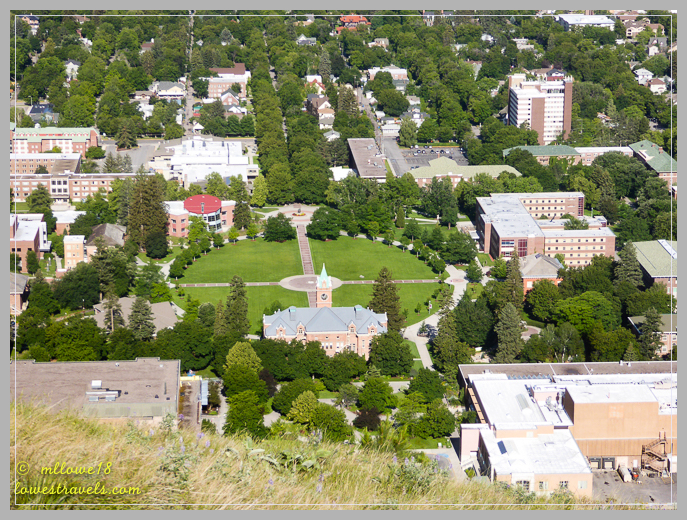
After the hike, we walked around the campus and looked up at where we had gotten our morning exercise:

We love supporting local farmer’s markets, and Missoula had three of them. Visiting the Clark Fork Market, I grabbed some pastries and delicious huckleberries to keep my sweet tooth appeased:
Hidden away in Missoula’s surrounding mountains are plenty of hiking opportunities, and we managed to tackle two of them. We followed Ravine Creek Trail #34 from Lolo National Forest and Sawmill-Curry Gulch Loop Trail in the Rattlesnake Wilderness Area. They were moderate hikes between 6-7 miles, and we enjoyed them both.
We were happy that we crossed paths with Donald and Gail of Winecoasters Blog, meeting up with them at Highlander Brew Co. for hours of RV’ing and travel stories. We’re planning to get together with them again in Florida next January. Thanks for the yummy pizza, we owe you one!

Arlee, Montana
One morning I visited a Buddhist garden of peace called the Garden of 1,000 Buddhas. Located about 29 miles north of Missoula, it’s dedicated as an International Peace Center, open to all faiths to come and experience peace, enjoy the Montana outdoors, and learn about Tibetan Buddhism. Click here to learn more about this interesting place.

The statuary is arranged in the formation of a “wheel of dharma”, meant to represent the “Noble Eightfold Path” which encompasses the eternal cycle of life, death, and rebirth. I followed a path in a clockwise direction to find peace along the way. Unfortunately, “lawnmower man” was at work that day and he shattered my experience of peace and tranquility. But I did find a variety of statues, ponds and vibrant flowers that created a nice contrast to the white buddhas and stupas with their inspirational quotations.
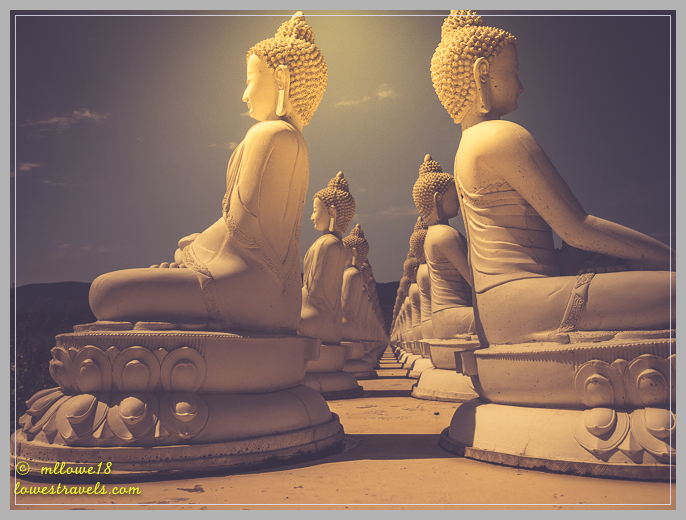

Anaconda, Montana
Not far from Butte, our next stop was highlighted by a massive smelter stack on the side of a mountain. At 585′, the old Anaconda Copper Company smelter stack, completed in 1919, is one of the tallest free-standing brick structures in the world.

On our first full day, we took a nice 6-mile hike at nearby Lost Creek State Park. We trekked along a 3,000′ deep canyon with gray limestone cliffs and pink and white granite formations.
Not wanting to miss out on the brewery-rich environment here, we followed our hike with some excellent brews at Smelter City Brewing. The beers were excellent, and the retro-rebuilt bar made it one of our favorites in a long time. We just wished they served food, because after that hike I ate about 5 bowls of popcorn!
Philipsburg, Montana
Following a suggestion from the pourer at the brewery, we drove the Pintler Scenic Highway from Anaconda the next day to check out the restored mining town of Philipsburg. The Hwy 1 scenic byway follows the northern shoreline of Georgetown Lake, a beautiful and busy mountain lake tucked away at the base of the Anaconda Range.

Philipsburg is listed in the National Register of Historic Places as a best-preserved late 19th century mining town. Silver, Sapphire and Manganese mining led to its boom and growth, but now the economy is based on agriculture, logging and tourism.
Butte, Montana
We passed through Butte on our way to a hike at Thompson Park, and when we saw the town up on the hill we were intrigued. We wanted to learn more, and what better way to do that than take a narrated trolley tour? Butte was and still is a mining town. In the late 1800s, it was deemed “the richest hill on earth”, thanks to the mining of gold, silver, and copper. But it was copper that put this town on the map, as it produced a fourth of the world’s copper after three men emerged as “copper kings”. Evidence of the massive mining operations remains, with many headframes standing over the tops of the 10,000 miles of underground excavations.
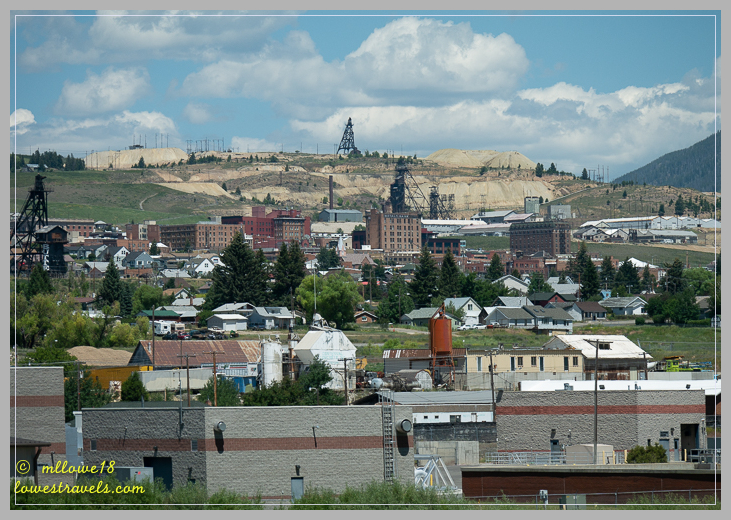

Unfortunately, Butte has more recently become infamous due to the unintended creation of a toxic lake known as the Berkeley Pit. The closure of Kelly Mine, a former copper open-cast mine, gave rise to a “lake” that turned into a nasty toxic and highly acidic cocktail of heavy metal and hazardous chemicals. In 1995, and again in 2016, thousands of Snow Geese died when they made a stopover at the pit on their southward migration.
The pit now has a 24-hour birdwatch program to prevent birds from landing in the water. Click here for an interesting article about their bird deterring efforts. Along with the upper Clark Fork River headwaters at Butte, the pit has been declared a superfund site due to its highly contaminated groundwater, surface water and soil.
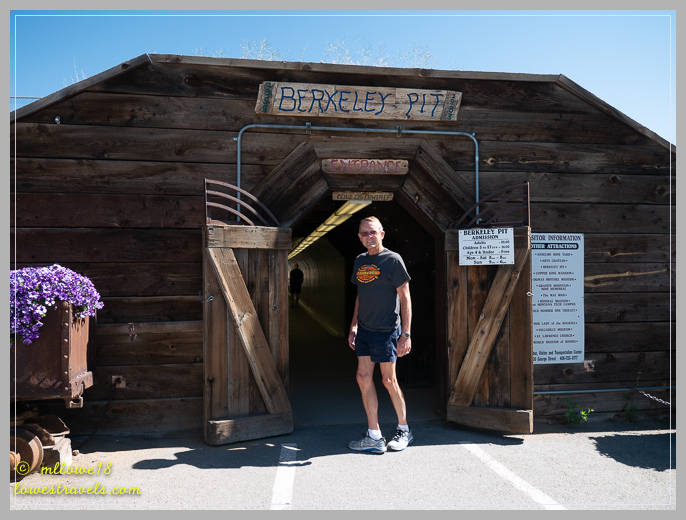
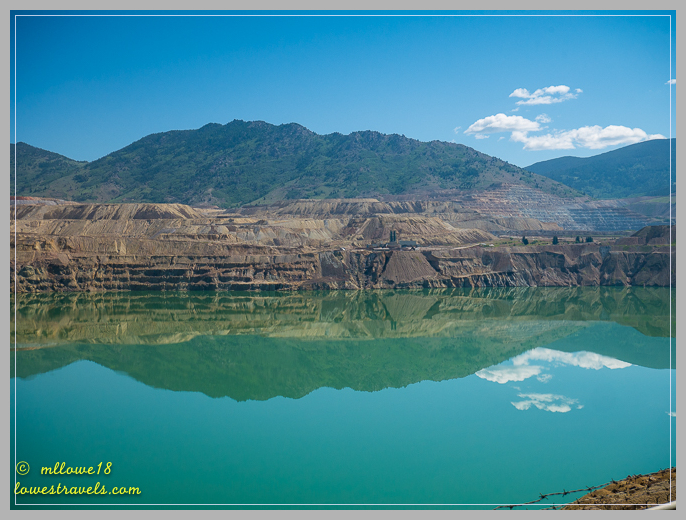
At the World Museum of Mining, we enjoyed touring and exploring a town’s mining legacy through a mock-up of a Wild West frontier mining town of the 1880’s. Built around the original 100′ tall headframe of the former Orphan Girl Mine, the various displays showed the technological and social history of mining focused on dozens of mines in the Butte area. Steve enjoyed this tour a bit more than I did – it must be a guy thing!
On the guided underground mine tour we were told about a fiery disaster in one mine that killed 166 miners in 1917. We also learned that thousands of mules played a major role in getting ore from the mines, living and working underground their entire lives.
Unrelated to mining, we saw the Our Lady of the Rockies statue standing 3,500′ above Butte on the Continental Divide.

We found Butte to be a very interesting city, well worth spending some time to poke around in. While we wouldn’t want to live there, its history and unique mining history make it an interesting and worthwhile stop.

That wraps up our visit to quaint and historic towns in beautiful Montana!






















That was a jam-packed leg of your journey! How on Earth do they keep birds from landing on that big, icky lake?
That’s two weeks worth of activities! They are doing anything and everything to keep birds away like using bird wailers, fireworks, Hawk calls, blare from speakers, sirens surrounding the pit which we heard when we were there and new tech like radar, laser systems and noise-making cannons etc.
Two weeks of cool stuff! That is quite the list of bird-shooing methods — sad that it has to be that way, but glad the efforts are being made.
Check this article by Audobon about their efforts. https://www.audubon.org/news/lasers-drones-and-air-cannons-inside-effort-save-migrating-waterfowl-toxic-death
Thank you!!
Montana has lots of interesting and scenic areas to explore doesn’t it! I especially loved your photos of the Garden of 1000 Buddhas. Too bad lawnmower man was on duty that day but I suppose it helped hone your powers of concentration! I, too, wonder how they keep birds from landing on the lake.
I just visited there and they have this randomly set sci-fi ray gun noise that goes off to keep birds from landing in the pond. Before this they had nothing and to keep birds away and they had a large flock of Canada Geese land and die in the water.
When we were there we heard blare from speakers, sirens surrounding the pit. New technologies are implemented like radar, laser systems, and noise-making cannons and other bird-deterrent program. It is definitely a mess! Here is an interesting article from Audobon that talked about the deadly Snow Geese stopover at the pit
Another wonderful and fun tour. Gail doesn’t seem to be posting anymore. I’ve always enjoyed her photography. Sounds like you had an enjoyable get together!
Yes, that was a last minute meet up for we only had one day of overlap. Great folks, and hope to meet them again in Florida.
Great trip! I have been to orofino many times and there are some really pretty areas just to the east of town up in the hills. An old railroad line has some impressive trestles just above Orofino. Also I was in Butte just two weeks ago and visited many sites as you did. Check out my adventures in Butte on my blog. I had to break it into three parts to cover it all. exploringwitheriks.wordpress.com
I agree with you, we wished we had stayed longer for there are trails to follow there. Sometimes you wont know whats out there until you visit the place.
What an interesting post MonaLiza. So much information and fun things to see and do. I love the small towns! Great photo of you and “the old man”!
Glad you noticed my pose with the old man 🙂
I think as writers we tend to remember more than our counterparts. Mui often fails questions about our past trips … except when there is a memorable food experience … those he remembers well and I fail miserably.
That is our secret for remembering almost everything plus we take the pictures and manage them which guarantees a fail safe memory. But when Steve asked me when was the last maintenance he did on Betsy, then he has the edge at that point.
You discovered so many interesting places in your Montana tour! The only place we’ve been is Missoula, and we really enjoyed the town and loved visiting the beautiful Garden of 1000 Buddhas. Fortunately, there was no lawn mowing the day we were there. Your photo of the Buddhas is such a unique perspective—it’s gorgeous. And Philipsburg looks like an interesting little town.
That toxic lake in Butte—what a mess is right! I hope they’re successful in keeping the birds from landing.
Oh Laurel when you read this article by Audobon about the deadly stopover by the Snow Geese you will be depressed but happy to know that they care about the birds as well. https://www.audubon.org/news/lasers-drones-and-air-cannons-inside-effort-save-migrating-waterfowl-toxic-death
I didn’t know about that toxic lake until you wrote about it. 😦 The hopeful part is that people seem to care about what happens to the migratory birds and are trying to figure out how to save them. Thanks for sharing the link, ML. I feel so badly for the birds—it’s amazing that they manage to survive the modern world and the hazards we’ve created.
It is sad but glad that they are doing something about it. There is even a little shack there that monitors any activity on the toxic lake.
I was a bit turned off by that lawnmower man, he just destroyed my peace and quite! We were saddened when the guide told us the thousands of birds that died just because they rested there, really sad. It seems they are trying all kinds of old and new technology to keep those birds away.
Your memory still blows me away. I can’t remember where we were last week, forget several years ago! That is impressive, and an interesting thing to consider each year as you travel – farthest location in any direction.Your photos from the Buddhist garden are just beautiful. What a wonderful place to spend an hour or two…when the lawnmower guy is on a break. Sheesh… talk about ruining the whole moment. Oh well. Still pretty in the pictures! The little towns look pretty cool too, though, I think I would steer clear of anything labeled a “superfund site.” That is just awful. At least they’re trying to do something to spare the wildlife. So sad….
You probably would have freaked out if I told you the exact week we were in Yellowstone in 2007 🙂 I know that is why we wont live in Butte, scary stuff yet the tourguide claimed they have the best drinking water. You know why? because they are filtered three times!
We so love the state of Montana and could see ourselves living there someday. I would love to visit the 1,000 Buddhas Garden. Sounds like my kind of place. The music festival in Butte is certainly worth a visit. We have been there twice.